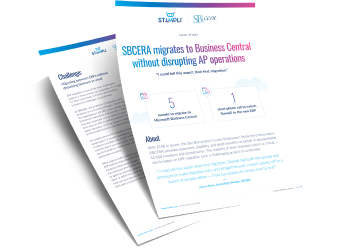SBCERA migrates to Business Central without disrupting AP operations
About SBCERA
With $14B in assets, the San Bernardino County Employees’ Retirement Association (SBCERA) provides retirement, disability, and death benefits on behalf of approximately 45,000 members and beneficiaries. The stability of their financial system is critical — which makes an ERP migration such a challenging project to undertake.
The Challenge & Solution
Challenge
Migrating between ERPs without disturbing business as usual
ERP migration is one of the most challenging projects a finance team can undertake. It’s complex, it’s time-consuming, and there are inevitably unexpected challenges along the way.
At SBCERA, the problems of migration were weighing on Accounting Manager, Jayson Eaton. The organization’s old ERP, once a reliable backbone of financial operations, had become a bottleneck. This was especially true in terms of ease of training new users as well as getting analytics to make better decisions. It fell to Jayson to lead the shift to Microsoft Dynamics 365 Business Central.
As complicated as the migration project was (it would span 4-5 months and take up nearly a quarter of Jayson’s available time each week), Jayson worried that it was even more complex due to their use of Stampli as a third-party accounts payable automation solution.
What Jayson really wanted was to swap out the ERP without impacting the AP process. After all, everyone liked using Stampli — not just in finance, but everyone who had to touch the system in order to approve invoices, answer questions, provide input or otherwise participate in the process.
But how can you migrate an ERP without disrupting the third-party systems that sit on top of it?
Solution
A seamless transition to migrate master lists such as vendors, GLs, entities and everything else
“I could tell this wasn’t their first migration,” said Jayson. “Stampli had both the people and processes to make migration easy and straightforward. I wasn’t passed off to a bunch of people, either — I had two points of contact end-to-end.”
Stampli has indeed turned ERP migration into a science. When a customer decides to migrate from one ERP to a new one, the process is carefully orchestrated to ensure a smooth transition — including migrating vendor data, matching new data sets, and maintaining business continuity.
Prep work begins a few weeks prior to cutover, when Stampli’s Customer Success team works with customers to understand the details of their environment, including the presence of any customizations or special export triggers, and to review the new ERP configuration considerations.
Following this, the customer prepares their account by processing all of the invoices and payments currently in Stampli. (This process avoids potential errors or duplicate entries after cutover.) Stampli’s team then updates the settings and runs a script to download the relevant data from the new ERP — ensuring that the new ERP is the source of truth from that moment forward.
Perhaps most importantly, Stampli also works with the customer to map key values for vendors, GLs and other fields from the old ERP to the new one.
Historical invoices processed through Stampli under the previous ERP are still accessible and not lost during the conversion process. This includes all activity, audit trails, conversations, documents, and other objects. The conversion maintains continuity for both the AP workflow and access to historical invoices.
In addition to the well-planned process, Jayson was even more impressed by the level of expertise of Stampli’s staff. “I didn’t know how familiar Stampli would be with SBCERA or with Business Central, but Jason and Jeremy at Stampli were really familiar with our existing process, and they knew everything there was to know about Business Central.”
For added risk reduction, Stampli gave Jayson access to a sandbox environment. “I was able to play around in an environment connected to our new ERP, try different invoices, and work out the kinks. It made things totally seamless.”
Hear it from the customer
I could tell this wasn’t their first migration. Stampli had both the people and processes to make migration easy and straightforward. I wasn’t passed off to a bunch of people, either — I had two points of contact end-to-end.
Bottom Line
Migration eased by our “ERP truth” philosophy
Users that have experience with Stampli competitors sometimes wonder why Stampli doesn’t let you create new vendors or GL accounts. The answer is simple: A business needs the ERP to be the source of truth in order to ensure data accuracy and consistency across the organization. A byproduct of this approach is that it makes ERP migration much easier, because Stampli simply switches from one source of truth to another — always staying in sync with the core ERP.
Preserving tribal knowledge
As an organization grows, sometimes tribal knowledge becomes a risk. This is especially risky for migration projects, because the things only one person knows may not be communicated to the project team. This risk is lessened with Stampli. “It’s so intuitive that you can easily train new people, and they don’t have to remember weird quirks,” said Jayson. “But what’s really helpful is that you can see what was done in the past — how things were coded, who the approvers were — so that new people and new systems are easy to get up to speed.”

How SBCERA Stepped It Up
Ready to take the next step?
Tell us what you’re looking to solve.
By submitting your information, you acknowledge that your data will be handled in accordance with Stampli’s Terms of Service and Privacy Policy, and you authorize Stampli to send you updates about Stampli products, services, and events.